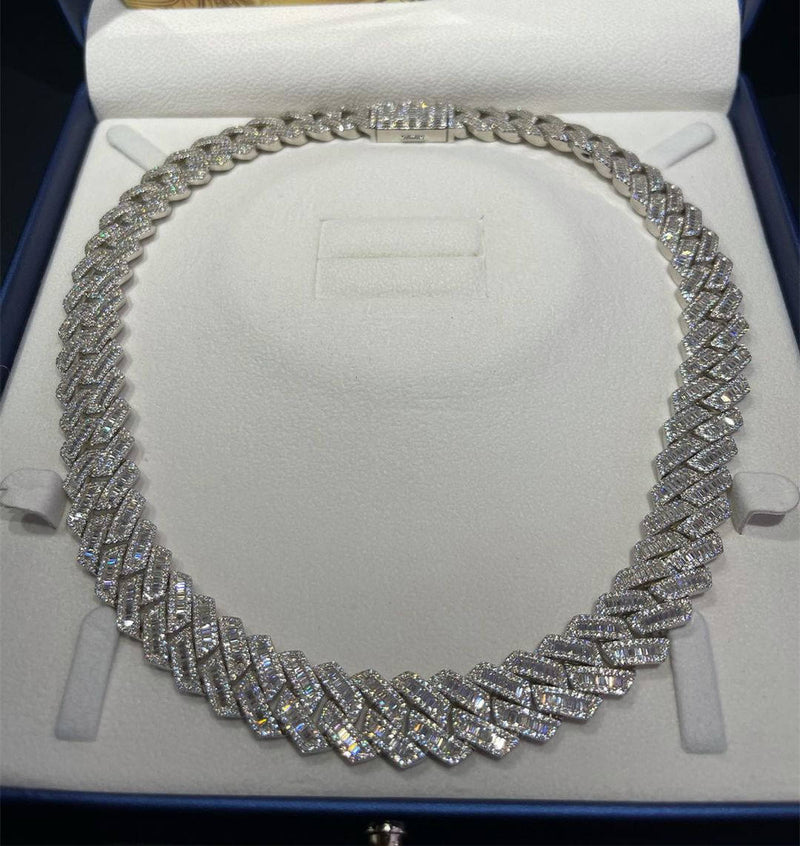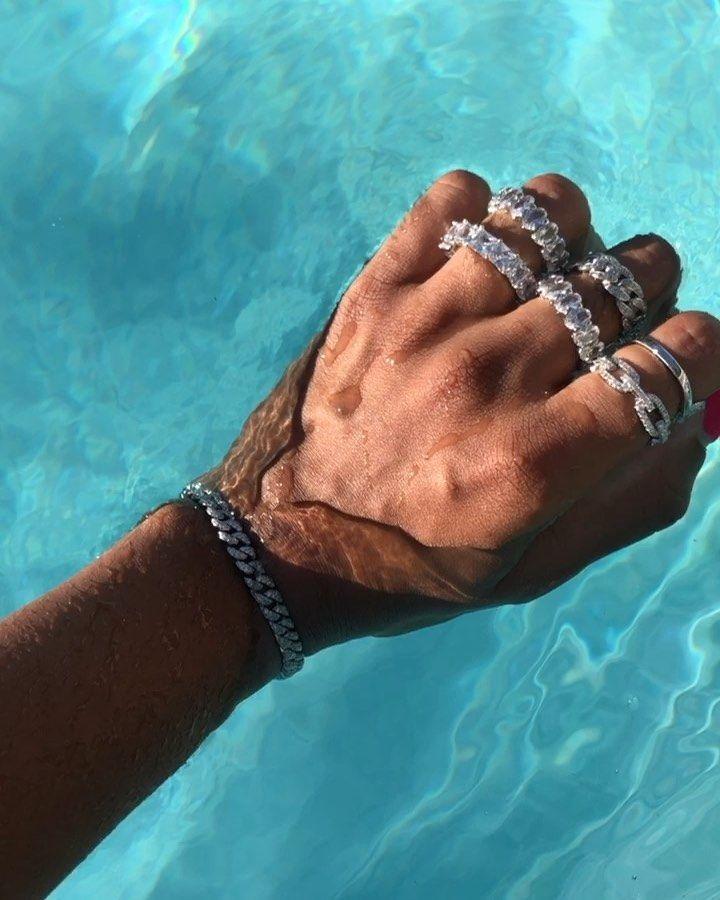
Moissanite vs Diamond: 4 Key Differences
While the center stone of an engagement ring is often a diamond in the United States, there are other options that can make an engagement ring just as beautiful. Another clear gemstones that is extremely durable is Moissanite. Let’s compare Diamonds vs Moissanite in color, hardness, brilliance, and price.
Moissanite vs Diamond, Color:
Mined Diamonds come in a variety of colors ranging from icy-white clear to yellow or gray hues. Like snowflakes, no two mined Diamonds will be the same. A mined gemstone's range of color variation is due to environmental factors the gemstone was naturally growing in. The more clear or white a Diamond appears, the more valuable and desirable it is considered to consumers.
Moissanite on the other hand, originates from space meteorites and is not a gem you find naturally on Earth. Due to this fact, all Moissanite gems are lab created because sourcing its natural form is nearly impossible in nature. Since new Moissanites are grown in labs, the environment the gemstone grows in can be controlled and regulated for more the most consistent and best production results.
Moissanites available on the market today are colorless. Moissanites range from colors equivalent to D-I range, or the two highest tiers on the color scale. All Moissanites and Moissanite engagement rings found on our website are from Charles and Colvard's Forever One collection, which are the highest quality stones available on the market today. They are guaranteed to be DEF in color and VS2 clarity or better.
Moissanite and Diamond Hardness
The harder a material, the more difficult it is to scratch or chip. While no gemstone is indestructible, some gemstones are slightly harder and more durable for daily wear. On the Mohs Scale of Hardness, Moissanite is rated as a 9.5 out of 10, which is higher than any gemstone used in jewelry besides Diamond itself. Diamonds are the hardest known mineral, scores a 10. For reference, rubies and sapphires have an Mohs score of 9, and emeralds have a score of 7.
Moissanite vs Diamond, Brilliance:
Brilliance, which refers to the gemstone's ability to reflect white light, is a good measure for how much ‘sparkle and fire’ a gem has. Brilliance relies on the gemstone's refraction. Moissanite disperses light very well and has higher light refraction than Diamond and will appear more brilliant. Additionally, Moissanite is less likely to attract grease or dirt over time than a Diamond due to its crystalline structure which should help keep the ‘sparkle’ longer in between cleanings.
Moissanite vs Diamond, Price:
Overall, Moissanite is a fraction of the high cost of a Diamond, and this is due to supply and demand since Diamonds are still fairly popular in the US for engagement rings. While a Diamond’s price varies based on cut, clarity, carat, and other individual characteristics, Moissanite stones are usually the same price and varies incrementally with the size and shape of the stone.
So...What is Moissanite Exactly?
Moissanite deposits are extremely rare on Earth. Technically, it’s a precious gemstone that comes from space. This brilliant stone was initially discovered by Nobel Prize winner Dr. Henri Moissan back in 1893, amongst the remnants of an ancient meteor crater in Arizona.
This remarkable diamond-like stone displayed superior brilliance, fire, luster, and hardness. However, due to the rarity of natural moissanite, there’s no way to collect enough to form a single piece of jewelry. Even scouring natural moissanite stone deposits in areas like Wyoming and Russia couldn’t yield enough material to make a set of earrings.
However, while researching to answer questions regarding what moissanite is, science was able to create a moissanite stone using a laboratory and an artisan's touch. Years of research, testing, and errors eventually lead scientists to artificially create a moissanite diamond from silicon carbide formed as a single crystal. This lavish gemstone is now available to those who are looking for a conflict-free and environmentally friendly alternative to a diamond.
Some may believe moissanite to be a “fake diamond”. While a comparison will show some similarities, there are notable differences (as we covered above).
History of Moissanite
Dr. Henri Moissan discovered a new crystal at the impact site of a meteor in 1893. However, at the time he mistakenly believed that he had come across diamonds due to their similar visual appearance.
A decade later, in 1904, under the examining eye of a chemist, it was soon proven that Moissan’s find was compositionally different from diamonds, having been formed of silicon carbide. Dr. Moissan would later win the 1906 Nobel Prize in Chemistry for his work in isolating fluorine from its compounds in 1886, an endeavor that saw him poisoned several times.
After Moissan’s initial discovery, moissanite would make few appearances outside of meteor craters. In fact, it would take half a century for the next natural moissanite deposit to be found.
Due to the lack of naturally occurring moissanite, its use as a decorative gemstone was impractical. However, this wouldn’t stop scientists from developing a method to create this wondrous diamond-like stone in a controlled environment. The 1980s saw the first creation of a lab-grown moissanite jewel. The brilliance and luster would outshine a traditional diamond while providing a conflict-free alternative at a fraction of the price.
This lab-grown jewel is not supposed to be a synthetic diamond, as it is expertly cut and crafted to bring out its own extraordinary properties.
These jewels are created through a safely guarded patented thermal growing process. Moissanite can be cultivated to deliver a near-colorless jewel or a select number of yellow, green, and gray shades.
As technology has advanced, so has the quality of moissanite. Under extreme monitoring, each stone is completely free from the types of foreign materials that are sometimes found in naturally mined gemstones. This allows the outcome of each moissanite diamond to be predetermined.
Our Promise
At The Real Jewelry Company, we strive to provide a superior alternative to diamonds. In our pursuit of excellence, all of our moissanite jewelry is conflict-free and an environmentally friendly choice.
General Benefits of Moissanite
Comparing the differences of a diamond vs moissanite, you might be unaware of the many advantages that lend itself to moissanite:
Conflict-Free
The greatest benefit that moissanite has over any other naturally mined gem is that, since it’s been created in a laboratory, you know that you’re wearing ethical jewelry.
Quality
Thanks to the meticulous environment that lab-grown moissanite jewels are produced in, if a gemstone isn’t the perfect clarity or has any form of obvious inclusions or blemishes, it won’t be up for sale.
High Refractive Index
A clear difference when performing a moissanite vs diamond side by side is the brilliance of each gem. Due to this jewel’s High Refractive Index, it can create a superior sparkle, unmatched by a standard diamond.
Timeless Appearance
For those looking for alternatives to a diamond, some may turn to cubic zirconia. However, unlike cubic zirconia, moissanite doesn’t develop a cloudy appearance over time. In fact, a moissanite jewel will maintain a cleaner look over a diamond. Dirt and oils will reduce the luster of a diamond faster than moissanite.
Moissanite Will Last Through the Generations
With superior hardness ratings, moissanite makes for a durable jewel. Proper care will allow a moissanite ring to be passed down through your family for years to come.
Moissanite vs Diamond, The Conclusion:
From a logical point of view Moissanite and Diamond have nearly identical visual characteristics. Both gemstones are clear and are two of the hardest gemstones known to man. Both exude incredible beauty, will last a lifetime, and are excellent options for everyday wear.
At the end of the day, Moissanites is a viable and equivalently beautiful symbol of love for those not wanting to purchase a Diamond due to ethical, environmental, or price concerns.
Moissanite Jewelry
The Real Jewelry Company jewelry use only the most brilliant colorless Moissanite stones. Amongst our jewelers and staff, our company features a deep history in collective experience in fine jewelry manufacturing, design, and sales; which will be evident the moment you see and wear our Moissanite jewelry. All of our Moissanite rings, solitaires, necklaces, stud earrings, bracelets, and other items use only the highest industry standard 925 sterling silver, 10k/14k / 18k yellow, white, and rose gold mixtures.
You can be 100% confident when shopping on our site that your order will receive the upmost care and attention from start to finish.



